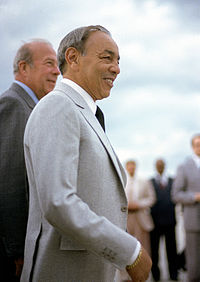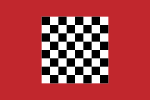Hassan II of Morocco
From Wikipedia, the free encyclopedia
| Hassan II of Morocco | |
|---|---|
| King of Morocco | |
 |
|
| Hassan II in Andrews Air Force Base, Maryland | |
| Reign | March 3, 1961 – July 23, 1999 (38 years) |
| Born | July 9, 1929 |
| Birthplace | Rabat, Morocco |
| Died | July 23, 1999 (aged 70) |
| Place of death | Rabat |
| Predecessor | Mohammed V of Morocco |
| Successor | Mohammed VI of Morocco |
| Royal House | Alaouite dynasty |
King Hassan II (Arabic: الحسن الثاني, class. pron. (a)l-ḥasan aṯ-ṯānī, dial. (Mar.) el-ḥasan ett(s)âni); July 9, 1929–July 23, 1999) was King of Morocco from 1961 until his death in 1999. He was the second eldest son of Mohammed V, Sultan, then King of Morocco and his wife Lalla Abla bint Tahar.
Contents |
[edit] Biography
[edit] Youth and education
King Hassan was educated at the Imperial College at Rabat and earned a law degree from the University of Bordeaux.
He was exiled to Corsica by French authorities on 20 August 1953, along with his father Sultan Mohammed V. They were transferred to Madagascar in January 1954. Prince Moulay Hassan acted as his father's political advisor during the exile. Mohammed V and his family returned from exile on 16 November 1955.
Prince Moulay Hassan participated in the February 1956 negotiations for Morocco's independence with his father, who later appointed him Chief of Staff of the newly founded Royal Armed Forces in April 1956. In the unrest of the same year, he led army contingents battling rebels in the mountains of the Rif. Mohammed V changed the title of the Moroccan sovereign from Sultan to King in 1957. Hassan was proclaimed Crown Prince on 19 July 1957, and became King on 3 March 1961, after his father's death.
[edit] Rule
Hassan's conservative rule, one characterized by a poor human rights record [1], strengthened the Alaouite dynasty. In Morocco's first constitution of 1963, Hassan II reaffirmed Morocco's choice of a multi-party political system, the only one in the Maghreb. The constitution gave the King large powers he eventually used to strengthen his rule, which provoked strong political protest from the UNFP and the Istiqlal parties that formed the backbone of the opposition. In 1965, Hassan dissolved Parliament and ruled directly, although he did not abolish the mechanisms of parliamentary democracy. When elections were eventually held, they were mostly rigged in favor of loyal parties. This caused severe discontent among the opposition, and protest demonstrations and riots challenged the King's rule.
In the early 1970s, King Hassan survived two assassination attempts. The first, in 1971, was coup d'état attempt supported by Libya and organized by General Madbouh and Colonel Ababou and carried out by cadets during a function at the King's summer palace in Rabat during his forty-second birthday party where large guests, including the Belgian Ambassabor Marcel Dupert were taken to house arrest, the King was taken to a small pavilion and Rabat's main radio station was taken over which broadcast propaganda that the King has been murdered and a republic has been founded. The coup ended the same day when royalist troops took over the palace in combat against the rebels. On August 16, 1972, during a second attempt, four F-5 military jets from the Royal Moroccan Air Force fired upon the King's Boeing 727 while he was traveling back to Rabat from France, but they failed to bring it down. General Mohamed Oufkir, Morocco's defense minister, was the man behind the coup and was officially declared to have committed suicide after the attack. His body, however, was found with several bullet wounds.[2]
In the Cold War era, Hassan II allied Morocco with the West generally, and with the United States in particular. There were close and continuing ties between Hassan II's government and the CIA, who helped to reorganize Morocco's security forces in 1960. [1] Hassan served as a back channel between the Arab world and Israel, facilitating early negotiations between them. This was made possible due to the presence in Israel of a large Moroccan Jewish community.
During his reign, Morocco recuperated the Spanish-controlled area of Ifni in 1969, and seized two thirds of Spanish Sahara (now Western Sahara) through the "Green March" in 1975. The latter issue continues to dominate Moroccan foreign policy to this day. Relations with Algeria have deteriorated sharply due to the Western Sahara affair, as well as due to Moroccan claims on Algerian territory, which unleashed the brief 1963 Sand War.
Economically, Hassan II adopted a market-based economy, where agriculture, tourism, and phosphates mining industries played a major role.
The period from the 1960s to the late 1980s was labelled by the Moroccan opposition as the "years of lead" [3][4] and saw many dissidents jailed, killed, exiled or forcibly disappeared.
King Hassan II had extended many parliamentary functions by the early 1990s and released hundreds of political prisoners in 1991, and allowed the Alternance, where the opposition assumed power, for the first time in the Arab World. He set up a Royal Council for Human Rights to look into allegations of abuse by the State.
[edit] Family
King Hassan II had five children with his wife Lalla Latifa Hammou, a member of the Zaiane tribe, whom he married in 1961 :
- HRH Princess Lalla Meryem (b.1962)
- HM King Mohammed VI (b.1963)
- HRH Princess Lalla Asma (b.1965)
- HRH Princess Lalla Hasna (b.1967)
- HRH Prince Moulay Rachid (b.1970)
The king also had one other wife, Lalla Fatima bint Qaid Amhourok. Married also in 1961, they had no children.
The father of Hassan II was Mohammed V of Morocco, his mother was Lalla Abla bint Tahar. King Hassan II had five sisters and one brother:
- Lalla Fatima Zahra, born June 29, 1929, (from the first marriage of Mohammed V of Morocco)
- Lalla Aicha, born June 17, 1930 in Rabat (from the second marriage of Mohammed V, with Lalla Abla)
- Lalla Malika, born March 14, 1933 in Rabat (from the second marriage of Mohammed V)
- Moulay Abdallah, born July 30, 1935 in Rabat, died in 1983 (from the second marriage of Mohammed V)
- Lalla Nuzha, born 1940 in Rabat, died in 1977 (from the second marriage of Mohammed V)
- Lalla Amina, born in Madagascar, April 8, 1954 (from the third marriage of Mohammed V of Morocco, with Lalla Bahia, died in September 2008[5])
[edit] See also
[edit] References and links
- ^ BBC NEWS | Africa | Morocco 'Facebook prince' pardon
- ^ "Interview with Malika Oufkir". Foreign Correspondent. November 7, 2001. http://www.abc.net.au/foreign/stories/s340307.htm.
- ^ BBC NEWS | Programmes | From Our Own Correspondent | Laughter, freedom and religion in Morocco
- ^ Morocco - Britannica Online Encyclopedia
- ^ http://www.map.ma/fr/sections/activites_princieres/deces_de_lalla_bahia2006/view
[edit] External links
- Morocco Alaoui dynasty
- History of Morocco
- Boeing 727 Program Breakthroughs
- The following link coming from ABC newspaper depicts the new rapprochement in April 6, 1956 between Spain and Morocco after the latter's independence. From left to right in the front row behind the balcony are the following personalities: Ahmed Belbachir Haskouri wearing a round fez, General Mohamed Oufkir who was part of the military protocol at the time and who later became the right-hand man for King Hassan II of Morocco, Crown Prince Hassan II, Sultan Mohammed V wearing dark glasses and General Francisco Franco.
http://sites.google.com/site/infanteriatoledo/en-la-academia-de-infanteria-de-toledo
|
Hassan II of Morocco
Born: 9 July 1929 Died: 23 July 1999 |
||
| Regnal titles | ||
|---|---|---|
| Preceded by Mohammed V |
King of Morocco 1961-1999 |
Succeeded by Mohammed VI |
|
|||||

